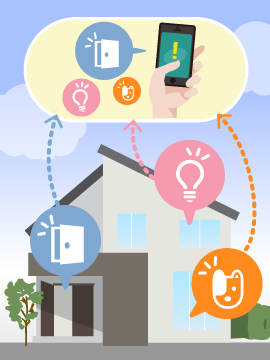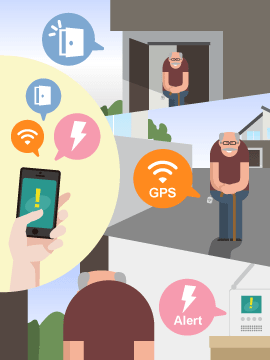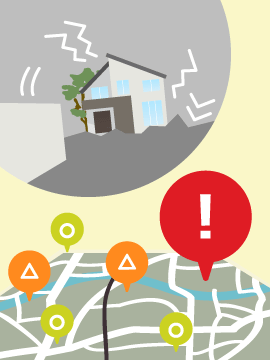IoT is an abbreviation for the Internet of Things.
Until recently, many physical objects - with the exception of personal computers and smartphones- had no means to connect to the internet until the advent of IoT technology.
We are now entering an age where devices exchange information on the internet, enabling us to remotely operate devices and collect data. With this technology, you can remotely control the temperature and humidity levels of the air conditioner at your home and detect anomalies inside the house.
It is a never-ending challenge using sensors to help us collect a myriad of data!
In this article, we introduce sensors used in IoT applications.
Content
1.What are the Roles of IoT sensors?
IoT innovation made it possible to connect everyday things to the internet. Nowadays, almost all entities, such as houses, office buildings, factories, and even cities are connected to the network to collect data and utilize the information for various purposes.
The importance of data has increased greatly, with many experts saying “data is the new oil.”
Sensors play an important role in creating solutions using IoT.
Sensors are devices that detect external information, replacing it with a signal that humans and machines can distinguish.
Sensors made it possible to collect data in most any situation and are now used in various fields - medical care, nursing care, industrial, logistics, transportation, agriculture, disaster prevention, tourism, regional businesses and many more.
With the expansion of the fields in which sensors play an important role, the market is still growing with a variety of sensors.
2.How and Where IoT Sensors are Used
There are a wide range of IoT sensors used to detect and measure various physical phenomena such as heat and pressure as well as the five human senses: sight, hearing, touch, taste and smell.
Example of sensors that detect physical properties
- Temperature and humidity sensors
- Acceleration sensors
- Gyro sensors
and many more sensors.
Examples of sensors that detect the five human senses
- Thermistors
- Sound pressure sensors
- Odor sensors
- Imaging sensors
and many more sensors.
Sensor types by communication interface
Sensor types vary depending on the sensing object, but in terms of communication interface, they can be roughly categorized into three types.
USB sensors
This type of sensor incorporates a common standard interface like USB which you can connect directly to your IoT devices or a single-board computer to add sensing capabilities.
With a USB extended type sensor, you can plug into a USB port of a single-board computer to receive power and create a data acquisition program to load the sensor data.
Moreover, this type of sensor allows connection to the internet via a single-board computer which you can easily build IoT devices.
Wireless & Bluetooth® sensors
The major wireless communication used in this type of sensor is Bluetooth® but there are also options based on 3G, 4G and LPWA network communications.
The Bluetooth®-enabled sensor, which is the most commonly offered wireless type sensor, allows data to be transferred to the central terminal for processing on a regular basis. For 3G, 4G and LPWA-enabled sensors, data is sent to the cloud for processing.
Many of the wireless type sensors incorporate button or coin cell batteries that allow sensors to acquire data as long as the battery keeps feeding power. The wireless communication function included in these sensors enables you to send the acquired data to other devices.
Embedded sensor modules

Embedded type sensor is installed inside a single board computer or a power drive case.
A sensor module is placed on the printed circuit board so at the very least, all you need is a power supply circuit.
This type of sensor is integrated into robots and single-board computers to monitor the operating condition.
3.Types of IoT Sensors in Daily Products & Services
In today’s world, IoT sensors are extensively used in various fields.
Here are successful examples of IoT sensor applications.
Examples of IoT sensor applications

Home security service
Security services offer us the possibility to monitor our home from anywhere.
All you need is a dedicated security device set up in your home and a security app downloaded to your smartphone to allow you to view your house and remotely control your home electronics and appliances. Such a service can help keep you monitor your elderly parents. Or, you can remotely monitor your children at home while you are away..
In the home security field, a wide variety of sensors are used with wireless camera networks such as detecting doors and windows open/close status, warning you if you left a window or a door open, monitoring and measuring room temperature, humidity and light intensity, and detecting motion when a person or an animal is in the room.
Online support service for business office
Services for office solutions include a real-time monitoring of the operation status of office electronics such as photocopiers, laser printers and multifunction peripherals over the internet.
By connecting equipment information such as toner levels and parts replacement cycle to dealers or customer service offices, the sensor can detect equipment failure or toner running out before users notice on their own.
This way, distributors can provide the right after-sales service at the right time, ultimately helping users save cost and the manufacturer to improve maintenance efficiency altogether.
Recent multifunction peripherals are installed with sensors that detect human motion, so when a person approaches a machine, it allows the machine to automatically turn on.
Wearable devices
Wearable devices monitor human posture, measure calorie burn and vital signs such as heart rate, just by wearing it on your body.
Data can be collected from sensors embedded in clothing or wearable devices attached to the body. Then, data is transmitted to the cloud via internet where it is accumulated and analyzed, enabling users to check their health conditions anytime.
Wearable devices are particularly playing a significant role in the healthcare industry, construction/building and logistics/transportation industries. In the healthcare sector, wearable devices can help monitor the health condition of, for example, patients with chronic illness and elderly people.
In the construction/building and logistics/transportation industries, wearables help improve the safety of workers, such as for heatstroke prevention while working outside under the sun and sleep monitoring to alert drivers.

Remote monitoring service for elderly people
Dementia is one of the biggest challenges facing society today. Older people with dementia may wander off, in some cases far away from home, and may get lose and unable to return back. getting lost and unable to return back. The number of people with dementia who were reported missing in Japan continues to rise year by year, reaching more than 15,000 in 2016 according to the 2017 report by the Japanese police force.
Monitoring is essential to keep people with dementia safe from wandering but looking after a person with dementia 24/7 on your own or hiring a caretaker can have a considerable stress on the person taking care of the patient. This is where sensors come into play for wandering protective devices.
- Placing human detecting sensor near entrances/exits of your home
- Attaching a GPS tracking device to the patient
- Placing a tracking device to send an alarm when the patient wanders away from the premises
The sensors set near entrances/exits of homes such as the front entrance and windows can help detect when the person in care tries to leave the house without supervision. Such products may be useful more for families taking care of older adults with dementia at home.
A GPS tracking device is a wearable IoT device to track the location of the person in care from smart phones.
A tracking device sends an alert if the person in care leaves a certain distance.
Sensors are embedded into everyday products like a watch or a shoe. These products are not only a solution to keep people with dementia safe from wandering but also for children from getting lost.
Women’s healthcare service
From the women’s healthcare perspective, sensors provide services such as ovulation and menstrual cycle prediction based on the collected body temperature data or detect abnormalities in the body and alert the user.
There are also services where you can send your daily body temperature readings from a digital basal thermometer to your smartphone simply by placing your phone over the thermometer. Most of these types of services can work with weight data from a scale and visualize how your body composition is changing over time.
There are many types of sensors used in digital thermometers but thermistors have been mostly used among them.

Hazard detection device
The level of damage from an earthquake depends on the construction of a building and the ground condition even if the buildings and houses are in the same region or have the same housing type. Generally, the damage degree of houses caused by an earthquake is larger for wooden houses compared to steel structure houses, and for old houses compared to new builds.
Structural damage is evident when a building collapse occurs but depending on the damage degree, it may not look obvious just by a glance. In some cases, while the building may remain intact, structural damage may be hidden and the building could become vulnerable to seismic damage. Post-earthquake building inspection is conducted by construction experts who determine the degree of damage, but it can be time consuming especially when the damage area is wider.
Such inspection to determine the degree of damage can be done using a hazard detection device. Most hazard detection devices measure and display the intense levels of shaking and damage to buildings and alert residents. By quickly detecting the damage level of the structure, hazard detection devices can guide you to decide whether to stay in your home or to evacuate to a shelter.
4.Summary
Sensors are clearly deeply rooted in our everyday life and business situations. They will be extensively utilized in various fields to respond to social needs in the future.
Particularly, with a feature that allows monitoring without human intervention, sensors will make an important contribution to work-style reforms.It might be worthwhile to consider integrating various types of sensors for your IoT business.
Omron has released its open-platform sensor evaluation board (Type: 2JCIE-EV) which enables easy sensor performance evaluation.
Please utilize the below "Contact Us Form" if you have any questions or comments regarding this IoT article.
OMRON’s Sensors
Contact us

